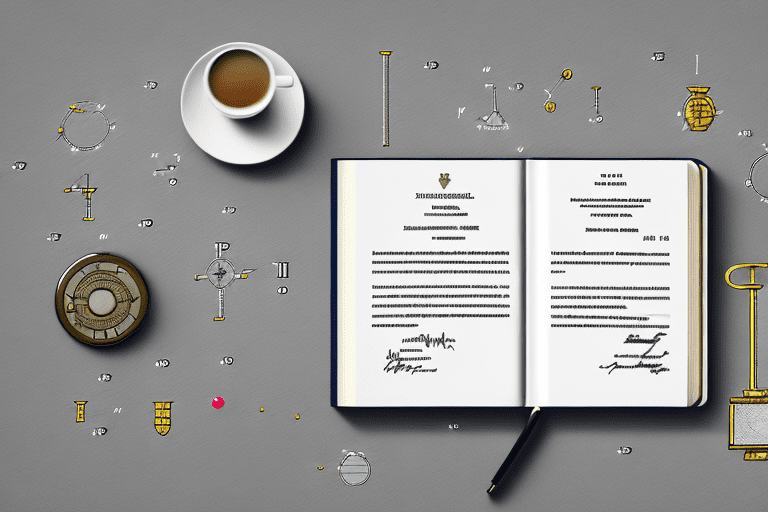In today’s world, the protection of intellectual property is of utmost importance. This is where copyright and patents come into play. Understanding these concepts is crucial for creators and inventors alike. Moreover, familiarity with the Manual of Patent Examining Procedure (MPEP) and the Patent Bar is essential for anyone interested in the field. In this article, we will delve into the basics of copyright and patents, explore the significance of the MPEP, and gain an overview of the Patent Bar.
Understanding Copyright and Patents
The Basics of Copyright
Copyright is a legal mechanism that grants exclusive rights to the creators of original works, such as literary, artistic, musical, and dramatic works. When a work is copyrighted, the creator has the exclusive right to reproduce, distribute, display, perform, and modify the work. This provides a level of protection against unauthorized use or copying by others.
Copyright protects not only the expression of an idea but also the underlying idea itself. It ensures that creators are recognized for their efforts and have control over how their work is used or monetized. This allows artists, writers, musicians, and other creators to have a fair chance at earning a living from their work.
For example, let’s consider a musician who has composed a beautiful symphony. With copyright protection, the musician has the exclusive right to perform the symphony in public, record it, and distribute it to the public. This means that no one else can perform or distribute the symphony without the musician’s permission. Copyright also allows the musician to earn royalties from the sale of their recordings or performances, providing a financial incentive for their creative work.
Furthermore, copyright protection extends to various forms of artistic expression, including paintings, sculptures, photographs, and even computer software. This ensures that artists and creators in different fields can safeguard their creations and prevent others from profiting from their work without permission.
What is a Patent?
A patent, on the other hand, is a legal protection granted to inventors for their inventions. It gives the inventor the exclusive right to make, use, sell, or import their invention for a limited period. This period is generally 20 years from the filing date, giving the inventor a monopoly over their invention during that time.
Obtaining a patent requires meeting certain criteria. The invention must be novel, non-obvious, and useful. It must also be adequately described and defined in a patent application. Once granted, a patent provides a legal framework for inventors to commercialize their inventions while preventing others from exploiting their ideas without permission.
Let’s take the example of a groundbreaking invention in the field of medicine. If a scientist discovers a new drug that effectively treats a specific disease, they can apply for a patent to protect their invention. With a patent, the scientist has the exclusive right to produce and sell the drug for a period of 20 years. This gives them the opportunity to recoup their research and development costs, as well as profit from their invention.
Moreover, patents not only encourage innovation but also promote the sharing of knowledge and advancements in various fields. By granting inventors exclusive rights, patents provide an incentive for researchers and inventors to disclose their inventions to the public. This disclosure allows others to learn from and build upon existing inventions, leading to further innovation and technological progress.
It’s important to note that patents can cover a wide range of inventions, including mechanical devices, chemical compounds, software algorithms, and even business methods. This broad scope of patent protection ensures that inventors in different industries have the opportunity to safeguard their inventions and reap the benefits of their innovative contributions.
Delving into the Manual of Patent Examining Procedure (MPEP)
The Purpose and Importance of the MPEP
The Manual of Patent Examining Procedure (MPEP) is a comprehensive guidebook used by patent examiners at the United States Patent and Trademark Office (USPTO). It serves as a valuable resource for understanding the patent examination process, establishing consistency in patent application reviews, and providing guidance to both examiners and inventors.
The MPEP is crucial in maintaining the integrity and uniformity of the patent examination process. It ensures that examiners follow consistent standards when evaluating patent applications, improving the quality and reliability of the patents granted. This, in turn, contributes to the stability and efficiency of the patent system.
The MPEP also plays a significant role in promoting transparency and fairness in the patenting process. By providing clear guidelines and instructions, it helps applicants understand the requirements and expectations for obtaining a patent. This transparency fosters trust in the system and encourages innovation by providing a level playing field for inventors.
Moreover, the MPEP serves as a reference tool for patent attorneys and agents, who rely on its guidance to assist their clients in navigating the complex patent system. It provides a framework for drafting strong patent applications, responding to office actions, and handling various legal issues that may arise during the examination process.
Navigating the MPEP: A Comprehensive Guide
Understanding the MPEP can be a daunting task due to its length and complexity. However, becoming familiar with its contents is invaluable, especially for patent attorneys, patent agents, inventors, and anyone involved in the patenting process.
The MPEP covers various topics, including patentability requirements, examination procedures, rules and regulations, and appeals. It provides detailed guidance on how to draft patent applications, respond to office actions, and navigate the intricate aspects of the patent system.
For example, the MPEP outlines the criteria for patentability, including novelty, non-obviousness, and utility. It explains the examination process, from the initial filing of a patent application to the final determination by the examiner. It also discusses the different types of office actions that an applicant may receive, such as rejections, objections, and requests for additional information.
In addition, the MPEP provides insights into the rules and regulations governing patent applications, including the requirements for drawings, specifications, and claims. It offers guidance on how to interpret and apply these rules, ensuring that applicants meet the necessary formalities and standards.
Though comprehensive, the MPEP should be used as a guideline, as it is subject to change over time due to updates in patent laws, court decisions, and evolving practices in intellectual property. It is essential for users to stay updated with the latest revisions and amendments to ensure compliance with the most current regulations and procedures.
In conclusion, the Manual of Patent Examining Procedure (MPEP) is a vital resource for the patent community. It provides a comprehensive guide to understanding the patent examination process and offers valuable insights into the requirements and procedures for obtaining a patent. By adhering to the guidelines outlined in the MPEP, patent examiners, applicants, and practitioners can contribute to the fairness, consistency, and reliability of the patent system.
The Patent Bar: An Overview
The field of intellectual property law is vast and complex, encompassing various aspects of protecting and managing inventions and innovations. Within this field, patent attorneys play a crucial role in assisting inventors and companies in securing patent rights for their inventions. A patent attorney specializes in patent law and is well-versed in the intricacies of the patent system.
The Role and Responsibilities of a Patent Attorney
When it comes to protecting inventions, patent attorneys are the go-to professionals. Their expertise lies in providing legal advice and guidance to inventors, ensuring that their inventions are adequately protected under patent laws. Patent attorneys assist inventors in conducting thorough patent searches to determine if similar inventions already exist, helping them assess the patentability of their ideas.
Once an inventor decides to pursue patent protection, the patent attorney drafts a patent application that accurately and comprehensively describes the invention. This process requires meticulous attention to detail, as even the slightest error or omission can jeopardize the patent’s validity. Patent attorneys work closely with inventors to understand the technical aspects of their inventions and translate them into precise and legally sound language.
During the patent prosecution process, patent attorneys advocate for their clients before the United States Patent and Trademark Office (USPTO). They respond to office actions, which are official communications from the USPTO that may require additional information or clarification regarding the patent application. Patent attorneys use their legal expertise to address any concerns raised by the USPTO and argue for the patent’s approval.
Furthermore, patent attorneys are responsible for staying up-to-date with the latest developments in patent law and the Manual of Patent Examining Procedure (MPEP). This ongoing education ensures that they can provide accurate and effective advice to their clients, helping them navigate the complexities of the patent system and make informed decisions regarding their inventions.
Preparing for the Patent Bar Exam
Becoming a registered patent attorney or agent requires passing the Patent Bar Exam, a comprehensive examination administered by the USPTO. This exam evaluates individuals’ knowledge of patent laws, regulations, and the MPEP. Successfully passing the exam is a crucial step toward a career in patent law.
Preparing for the Patent Bar Exam involves extensive study and a deep understanding of the patent system. Aspiring patent attorneys dedicate countless hours to learning and familiarizing themselves with relevant laws, regulations, and procedures. They delve into the intricacies of patent prosecution, patentability requirements, and the various legal doctrines that shape patent law.
Many individuals choose to enroll in specialized courses or study guides tailored to the Patent Bar Exam. These resources provide structured and comprehensive study materials, practice exams, and guidance from experienced patent attorneys. Through rigorous preparation, aspiring patent attorneys aim to develop a solid foundation of knowledge and enhance their ability to analyze complex legal scenarios.
Success in the Patent Bar Exam not only demonstrates a candidate’s understanding of patent law but also serves as a testament to their commitment and dedication to the field. It is a stepping stone toward a rewarding career as a patent attorney, where they can help inventors protect their intellectual property and contribute to innovation and progress.
The Interplay Between Copyright, Patents, and the MPEP
How Copyright and Patents Work Together
While copyright and patents are distinct forms of intellectual property protection, there can be instances where they overlap. For example, a patented invention may also be eligible for copyright protection if it is an artistic work or includes copyrighted material.
Moreover, copyrights may protect innovative aspects of a work that are not covered by patent law. For instance, a unique character or storyline in a video game can be copyrighted even if the game mechanics are patentable. Understanding the interplay between copyright and patents is essential for creators as it allows them to protect their creations to the fullest extent.
The MPEP’s Role in Patent Law and Copyright
While the MPEP primarily focuses on patent law, it also addresses various aspects related to copyright. This includes guidance on the patentability of software, digital technologies, and other creations that may be eligible for both patent and copyright protection.
Patent attorneys, inventors, and other stakeholders benefit from the MPEP’s comprehensive coverage, which aids in understanding the intersection between patent law and copyright. By considering the MPEP’s guidelines, creators can effectively navigate the intellectual property landscape and make informed decisions regarding their inventions and creations.
Conclusion: The Importance of Understanding Copyright, Patents, and the Patent Bar
As we explored the world of copyright, patents, the MPEP, and the Patent Bar, it becomes evident how crucial understanding these concepts is. Copyright and patents play a vital role in safeguarding intellectual property, rewarding creators and inventors, and facilitating innovation. Knowledge of the MPEP enables individuals to navigate the patent system effectively, while familiarity with the Patent Bar opens doors to a career in patent law.
Whether you are a creator, an inventor, or someone interested in the field, taking the time to comprehend copyright, patents, the MPEP, and the Patent Bar is a valuable investment. By doing so, you will be equipped to protect your ideas, advocate for your rights, and contribute to the vibrant world of intellectual property.






